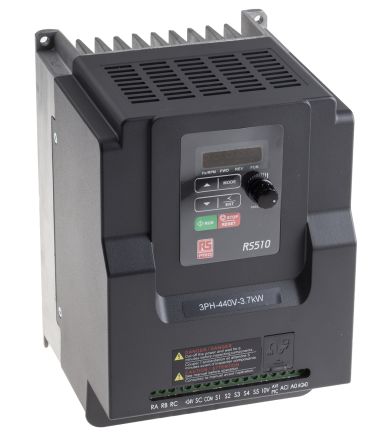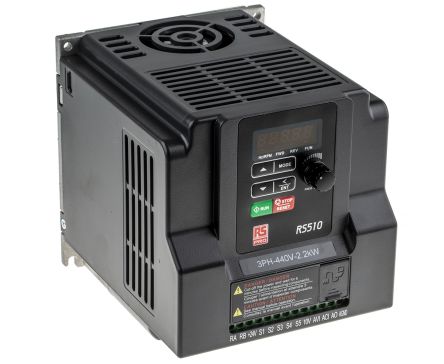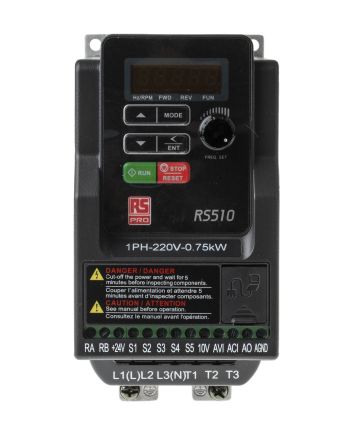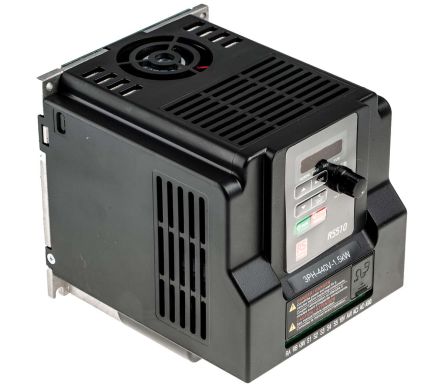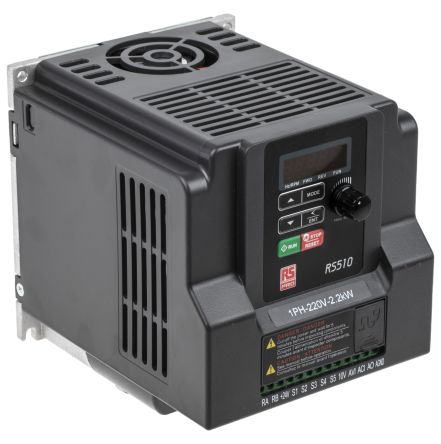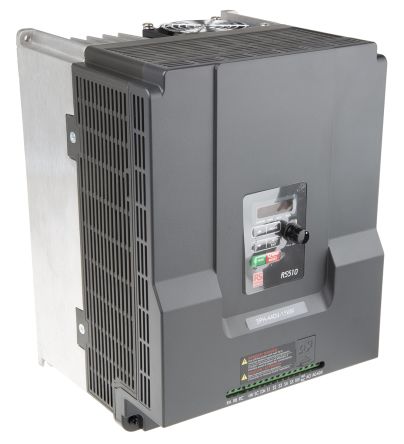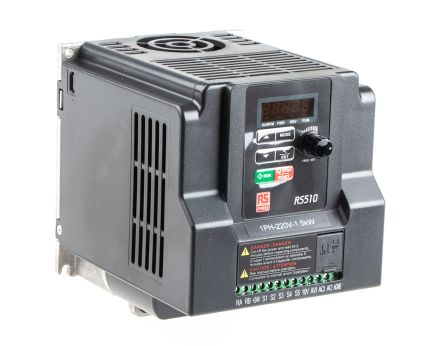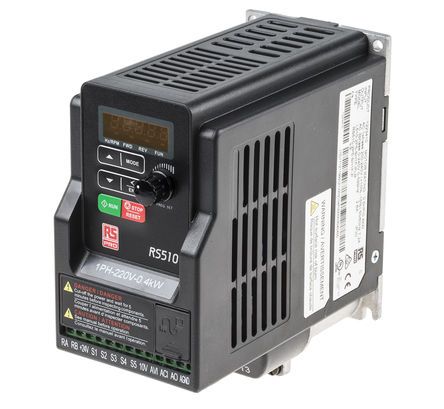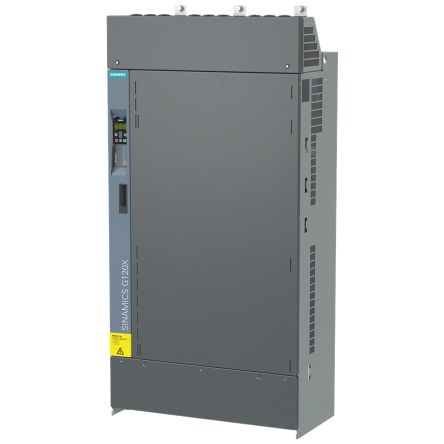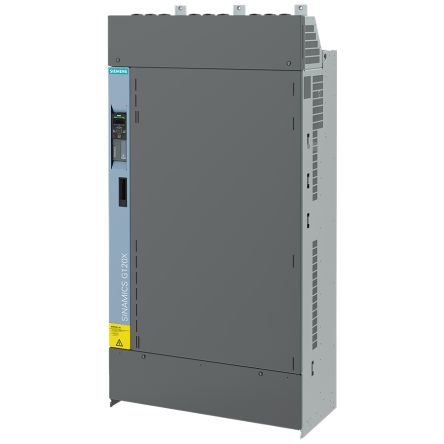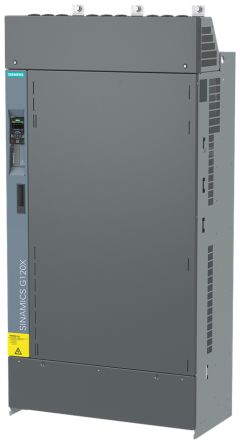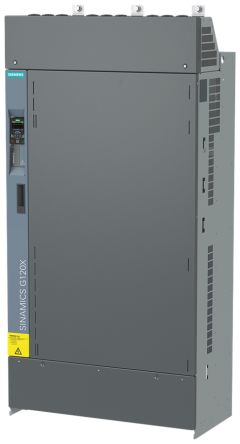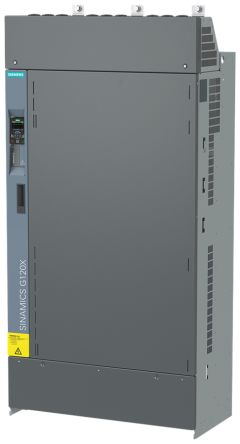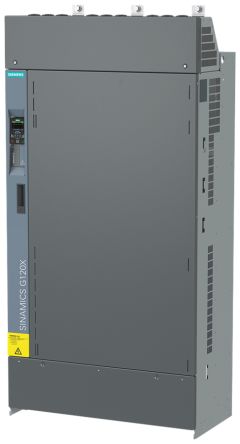- Automation & Control Gear
- Cables & Wires
- Enclosures & Server Racks
- Fuses & Circuit Breakers
- HVAC, Fans & Thermal Management
- Lighting
- Relays & Signal Conditioning
- Switches
- Batteries & Chargers
- Connectors
- Displays & Optoelectronics
- ESD Control, Cleanroom & PCB Prototyping
- Passive Components
- Power Supplies & Transformers
- Raspberry Pi, Arduino, ROCK, STEM Education & Development Tools
- Semiconductors
Inverter Drives
An inverter drive, also known as an adjustable frequency drive (AFD), variable frequency drive (VFD), or variable speed drive (VSD), is a type of motor control device that enables precise regulation of the speed and torque of an AC motor. By converting AC power to DC, inverter drives offer enhanced control capabilities, making them ideal for reducing electrical energy waste across various applications.
Inverter drives come in two primary configurations: single-phase and three-phase.
- Single-Phase Inverter Drives: These drives are designed for applications with single-phase AC power supplies, commonly found in residential and light commercial settings. They are suitable for controlling smaller motors used in appliances like fans, pumps, and air conditioners. Their design allows for easy integration into everyday devices, enhancing energy efficiency in smaller-scale operations.
- Three-Phase Inverter Drives: These drives are used in industrial applications with three-phase AC power supplies. Additionally, they are capable of controlling larger motors used in machinery, conveyors, and HVAC systems. It’s also worth noting that three-phase inverter drives offer higher efficiency and power output compared to single-phase drives, making them essential for demanding industrial environments.
At RS Philippines, we offer a range of inverter drives in different IP ratings from top brands known for their reliability and performance. This ensures that you can find the perfect inverter drive tailored to your specific needs.
How an Inverter Drive Works and Their Key Components
Inverter drives are essential devices that control the speed and torque of AC motors. They achieve this by regulating the frequency and voltage supplied to the motor, allowing for greater precision in machinery operations. Positioned between an electrical supply and a motor, inverter drives convert AC power to DC and then back to AC, enabling tailored power delivery for specific applications.
Inverter drives consist of several critical components that work together to provide precise motor control. Here are the main parts of a typical VFD:
- Rectifier: This component converts the incoming AC power supply to DC power, and it acts as the initial stage in the variable frequency drive’s power conversion process.
- DC Bus: The DC bus acts as a storage reservoir for the DC power generated by the VFD’s rectifier. At the same time, it helps smooth out voltage fluctuations and provides a stable DC voltage to the inverter stage.
- Inverter: The inverter is the heart of the VFD, and it converts the DC power back to AC power, but with a variable frequency and voltage. This variable output is what allows the VFD to control the speed of the AC motor.
- Control Circuit: As the brain of the variable frequency drive, the control circuit monitors various input signals, processes information, and adjusts the output frequency and voltage accordingly. It also handles functions like motor protection, communication, and user interface interaction.
- Operator Interface: The operator interface allows users to interact with the VFD. Additionally, it includes a display and keypad for setting parameters, monitoring performance, and controlling the inverter drive.
Types of Inverter Drives or Variable Frequency Drives
RS Philippines offer a wide selection of inverter drives tailored to various applications and control requirements. Our range includes the following types:
AC Inverter Drives
These are the most common type of inverter drive, providing basic speed and torque control for AC motors. They are suitable for a wide range of applications, from simple fan and pump control to more demanding industrial processes. These drives typically utilize voltage-source inverter (VSI) technology, which converts AC power to DC and then back to AC with adjustable frequency and voltage, allowing for smooth motor operation.
Variable Frequency Drives (VFDs)
Variable frequency drives offer precise control over motor speed by adjusting the output frequency. They are ideal for applications requiring accurate speed regulation and energy efficiency. VFDs can significantly reduce energy consumption, especially in systems like pumps and fans, where varying the speed can lead to substantial savings.
Variable Speed Drives (VSDs)
Variable speed drives provide adjustable speed control for motors, allowing for optimized performance and reduced energy consumption. While often used interchangeably with VFDs, VSDs may refer specifically to systems that focus on varying motor speed rather than just frequency adjustments.
Vector Control Drives
Vector control drives offer advanced motor control capabilities, providing precise torque and speed regulation even at low speeds. These inverter drives are ideal for applications requiring high dynamic performance and accurate positioning, such as robotics or CNC machinery. Vector control technology enhances the responsiveness of motors, making them suitable for complex tasks.
PID Control Drives
These inverter drives incorporate a PID (Proportional-Integral-Derivative) controller, enabling precise process control. This technology allows the drive to maintain stable operation even with varying loads by continuously adjusting the output based on feedback from the motor's performance. PID control is essential in applications where consistent performance is critical, such as in temperature or pressure regulation systems.
The Difference Between Variable Speed Drive and Variable Frequency Drive
The terms "variable speed drive" (VSD) and "variable frequency drive" (VFD) are often used interchangeably, but they still have subtle differences. For one, VSD is a broader term encompassing any drive that can vary the speed of a motor. This includes both AC and DC drives, as well as mechanical speed control methods.
A VFD, on the other hand, is a specific type of VSD that controls the speed of an AC motor by varying the frequency and voltage of the power supplied to the motor. Additionally, VFDs can vary speed control at start up, during the run, and at motor stop.
Features and Benefits of Using a Variable Frequency Drive
From enhancing energy efficiency to improving process control, inverter drives provide significant benefits for both industrial and commercial settings. Here are the advantages you can expect from an inverter drive:
- Precise Control of Motor Speed: VFDs allow for accurate regulation of motor speed by varying the frequency and voltage supplied to the motor. This capability enables smooth acceleration and deceleration, which is crucial for applications requiring dynamic speed adjustments.
- Energy Savings: By adjusting motor speed to match load requirements, VFDs can lead to substantial energy savings. For instance, in centrifugal pumps and fans, reducing speed can decrease energy consumption significantly—often by up to 50% at lower speeds due to the affinity laws governing pump performance.
- Control of Various Appliances: VFDs are versatile enough to control both small appliances, such as desk fans and pumps, as well as larger machinery requiring high torque, like conveyor systems and industrial compressors.
- User-Friendly Digital Interfaces: Many modern VFDs come equipped with digital operation LED input screens that facilitate easy parameter setting, input, and monitoring. This feature simplifies the setup process and allows for quick adjustments based on operational needs.
- Compact Design: The sleek and compact design of VFDs makes them suitable for a wide range of applications without requiring excessive space. This is particularly beneficial in environments where space is limited.
- Easy Installation: VFDs are designed for straightforward installation, allowing for quick integration into existing systems. This ease of installation can reduce downtime during upgrades or new installations.
- Safety Features: Many VFDs include emergency stop functions that enhance operational safety by allowing immediate shutdown in case of an emergency. This feature is essential for protecting both personnel and equipment.
- Advanced Control Capabilities: VFDs can be programmed with various control algorithms to optimize performance based on specific application requirements. Features such as PID control allow for precise adjustments in response to changing conditions.
Industrial Applications of Variable Frequency Drives
The ability of variable frequency drives to precisely control motor speed and torque offers significant advantages in various applications, including:
Manufacturing and Automation
In discrete manufacturing, variable frequency drives are used to control the speed of conveyor belts, robotic arms, and other automated equipment. This precise control allows for optimized production processes, improved product quality, and reduced energy consumption.
Pumps and Fans
VFDs are widely used in applications involving pumps and fans, such as HVAC systems and water management. By adjusting motor speed to match demand, variable frequency drives improve energy usage and reduce operating costs.
Compressors and Blowers
In process manufacturing and other industries that use compressors and blowers, inverter drives help regulate air pressure and flow. Additionally, this precise control enhances process efficiency, reduces energy waste, and extends equipment lifespan.
Material Handling
Variable frequency drives are also used in material handling equipment like cranes and hoists to provide smooth acceleration and deceleration, preventing sudden jerks and reducing wear and tear on the equipment.
Energy and Utilities
In the energy sector, inverter drives are used in power generation and distribution systems to control the speed of motors and generators, enhancing energy production and grid stability.
How to Select the Right Variable Frequency Drive Inverter
When choosing a variable frequency drive (VFD) or inverter drive requires, you must consider these factors:
Motor Requirements
Consider both your motor requirements and the specific needs of your application. Start by matching the variable frequency drive’s voltage and current ratings to your motor's specifications to ensure compatibility and prevent damage. Next, consider the speed range and torque demands of your application, as VFDs offer varying levels of control over these parameters. At the same time, choose a VFD with a suitable control method, depending on your motor type and desired level of precision.
Application Needs
Beyond motor-specific factors, evaluate the application's needs. For example, consider the operating environment, including temperature, humidity, and potential exposure to dust or liquids. And to ensure reliable operation in harsh conditions, select a variable frequency drive with appropriate ingress protection (IP) ratings to ensure reliable operation in harsh conditions. Additionally, determine the load characteristics, such as constant torque or variable torque, and the duty cycle of your application to ensure the VFD can handle the demands placed upon it. Finally, evaluate the VFD's programming capabilities and features, such as communication protocols and built-in protections, to ensure they align with your control and monitoring requirements.
Trusted Inverter Drives Manufacturer, Supplier, and Distributor in Philippines
For reliable and high-performance inverter drives, RS Philippines is your trusted source. We are a leading distributor of variable frequency drives, offering a wide selection of top-quality products from renowned brands like Siemens, Schneider Electric, and Omron. Whether you need an adjustable frequency drive for industrial automation, an IP66 variable speed drive, or a VFD inverter for precise motor control, we have the solution to meet your specific needs.
At RS, we also understand that finding the right inverter drive at a competitive price is crucial. That's why we offer a diverse range of VFDs at various price points, ensuring you get the best value for your investment. Browse through our range today and find inverter drives with different functionalities, power ratings, and communication options.
Buy Adjustable Frequency Drive Online from RS Philippines
Whether you need a variable frequency drive, power adapter, or any electrical component, you can conveniently order from RS Philippines through the following methods:
- Online: Browse our wide selection of adjustable and variable frequency drives, select the model that meets your needs, add it to your cart, and proceed to checkout.
- Phone: Talk to our sales team and place your order by calling us at +632 8888 4030.
We offer reliable delivery of variable frequency drives. Visit our Delivery page for more about our delivery services and fees.
Popular Searches
Related links
- Delta Electronics Inverter Drive 1 Phase 9.5 A, VFD-EL Series
- Eaton OPT Series Encoder for Use with Variable Frequency Drive, 39mm Length
- Eaton OPT Series Fieldbus Interface Module for Use with Variable...
- Schneider Electric Variable Speed Drive 3 Phase 10.4 A @ 380 V ac,...
- Danfoss Inverter Drive 3 Phase 147 A, P75K Series
- Eaton Adapter for use with Eaton Variable Frequency Drive SPX
- Delta Electronics Inverter Drive 3 Phase 32 A, VFD-MS Series
- Eaton OPT Series Analog I/O Module for Use with Variable Frequency...
